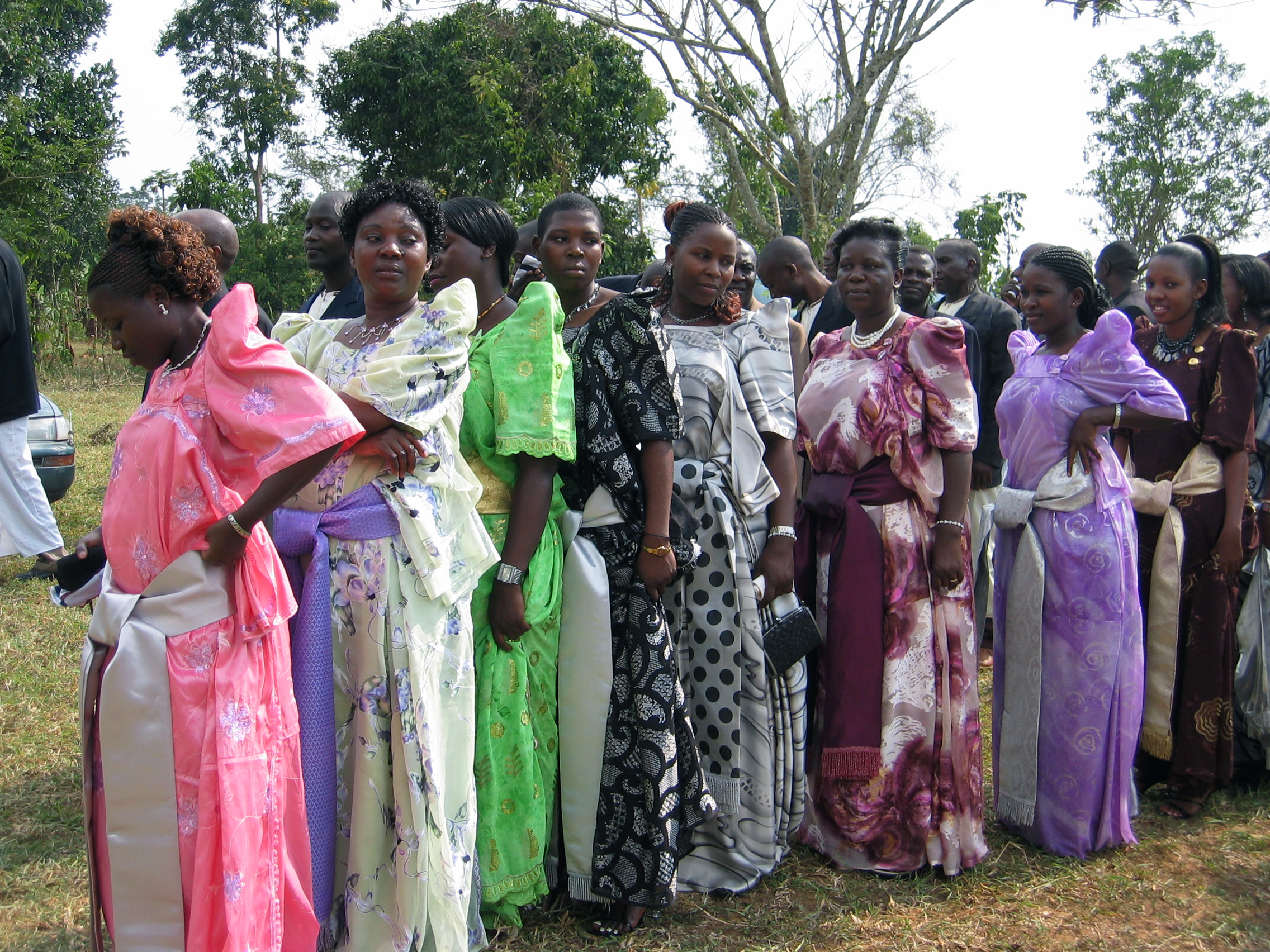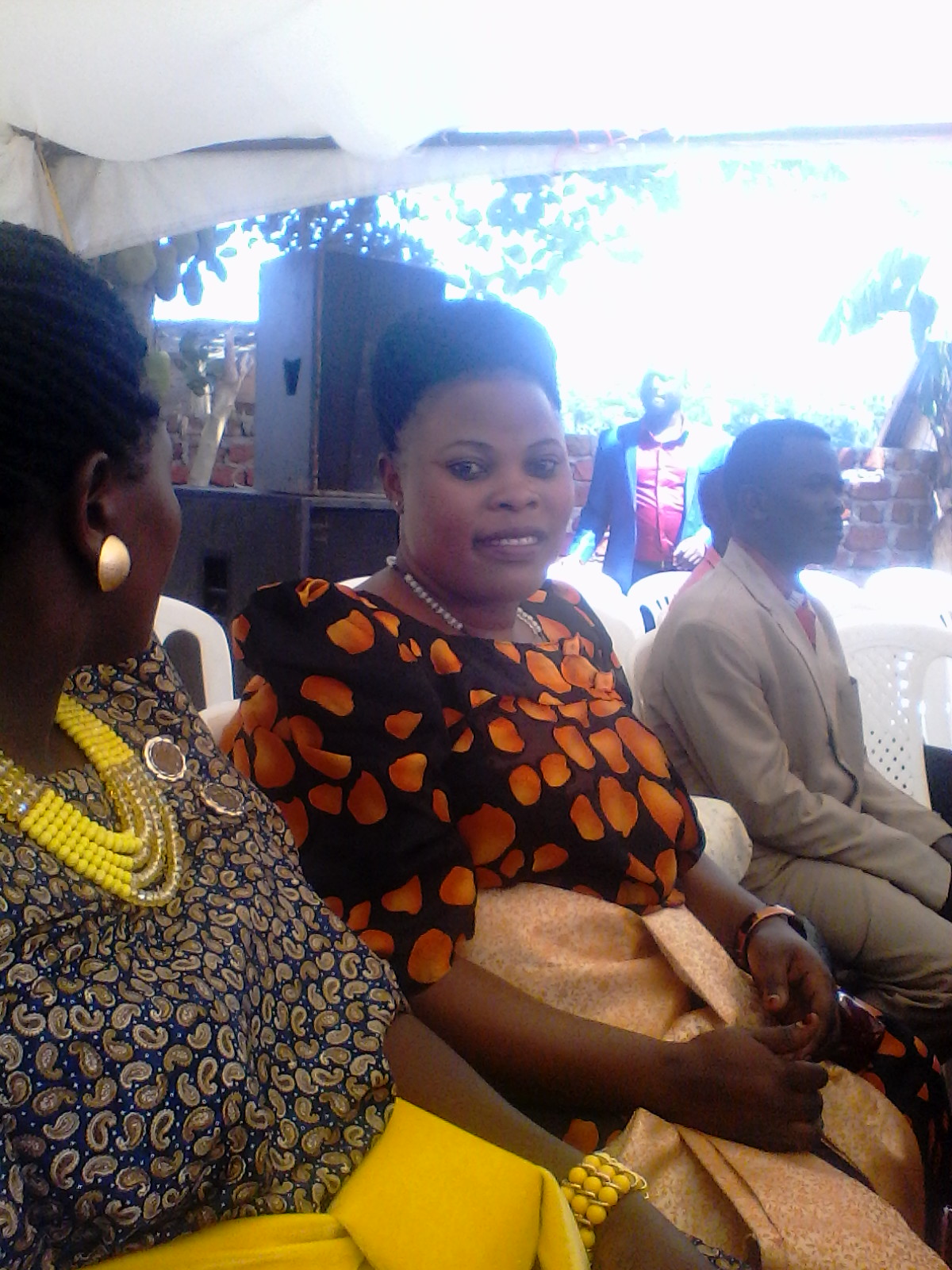Gomesi on:
[Wikipedia]
[Google]
[Amazon]
 A gomesi, also known as a Busuuti or Bodingi, is a colorful floor-length dress. It is the most commonly used costume for women in
A gomesi, also known as a Busuuti or Bodingi, is a colorful floor-length dress. It is the most commonly used costume for women in
 The gomesi is a floor-length, brightly colored cloth dress with a square neckline and short, puffed sleeves. The dress is tied with a sash placed below the waist over the hips. The gomesi has two buttons on the left side of the neckline. Most gomesi are made of
The gomesi is a floor-length, brightly colored cloth dress with a square neckline and short, puffed sleeves. The dress is tied with a sash placed below the waist over the hips. The gomesi has two buttons on the left side of the neckline. Most gomesi are made of
 A gomesi, also known as a Busuuti or Bodingi, is a colorful floor-length dress. It is the most commonly used costume for women in
A gomesi, also known as a Busuuti or Bodingi, is a colorful floor-length dress. It is the most commonly used costume for women in Buganda
Buganda is a Bantu peoples, Bantu kingdom within Uganda. The kingdom of the Baganda, Baganda people, Buganda is the largest of the List of current non-sovereign African monarchs, traditional kingdoms in present-day East Africa, consisting of Ug ...
and Busoga
Busoga (Soga language, Lusoga: Obwakyabazinga bwa Busoga) is a kingdom and one of four constitutional monarchies in present-day Uganda. The kingdom is a cultural institution which promotes popular participation and unity among the people of the ...
. Traditional male attire is the kanzu
A kanzu is a white or cream coloured robe worn by men in the African Great Lakes region. It is referred to as a ''tunic'' in English, and as the '' thawb'' in Arab countries. The kanzu is an ankle or floor length garment. It serves as the national ...
. The gomesi has had many changes in its uses and design since its origination.
Origins
The best scholarship traces the origins of the Gomesi to 1905. The dress was introduced by aGoan
Goans ( Romi Konkani: , ) is the demonym used to describe the people native to Goa, India, formerly part of Portuguese India (''Estado Português da Índia''). They form an ethno-linguistic group resulting from the assimilation of Indo-Aryan, ...
designer, Caetano Gomes, then resident in Uganda which was a British Protectorate at the time. The dress did not gain wide use until the wife of Daudi Cwa II of Buganda, the Kabaka
Kabaka is the title of the king of the Kingdom of Buganda.Stanley, H.M., 1899, Through the Dark Continent, London: G. Newnes, According to the traditions of the Baganda, they are ruled by two kings, one spiritual and the other secular.
The s ...
, or king over Buganda, wore it at her 18-year-old husband's official coronation (he had been kabaka since age 1) in 1914.Richard J. Reid. ''A History of Modern Uganda''. Cambridge: Cambridge University Press, 2017. p. 40
The gomesi can also be traced back to the former, traditional style of clothing in Uganda called Lubugo, originating in 600 AD. The women of Uganda adopted the gomesi once in was introduced by Europeans. The implementation of the gomesi can now serve as traditional, formal, and everyday clothing. When the gomesi is worn as causal clothing, it is usually one made of lighter weight and less formal fabrics.
This article of clothing has gone through four main stages of evolution, with changes in material and decorative style, starting in the 1960's. The gomesi originated as bark-cloth, and then developed into a cotton gomesi in the 1960's. By the 1970's it transformed into a Khadi
Khadi (, ), derived from khaddar, is a hand-spun and woven natural fibre cloth promoted by Mahatma Gandhi, Gandhi as Swadeshi movement, ''swadeshi (of homeland)'' for the freedom struggle of India and the term is used throughout the Indian sub ...
gomesi, and most recently a kikooyi gomesi.
Design
 The gomesi is a floor-length, brightly colored cloth dress with a square neckline and short, puffed sleeves. The dress is tied with a sash placed below the waist over the hips. The gomesi has two buttons on the left side of the neckline. Most gomesi are made of
The gomesi is a floor-length, brightly colored cloth dress with a square neckline and short, puffed sleeves. The dress is tied with a sash placed below the waist over the hips. The gomesi has two buttons on the left side of the neckline. Most gomesi are made of silk
Silk is a natural fiber, natural protein fiber, some forms of which can be weaving, woven into textiles. The protein fiber of silk is composed mainly of fibroin and is most commonly produced by certain insect larvae to form cocoon (silk), c ...
, cotton
Cotton (), first recorded in ancient India, is a soft, fluffy staple fiber that grows in a boll, or protective case, around the seeds of the cotton plants of the genus '' Gossypium'' in the mallow family Malvaceae. The fiber is almost pure ...
, satin
A satin weave is a type of Textile, fabric weave that produces a characteristically glossy, smooth or lustrous material, typically with a glossy top surface and a dull back; it is not durable, as it tends to snag. It is one of three fundamen ...
, polyester
Polyester is a category of polymers that contain one or two ester linkages in every repeat unit of their main chain. As a specific material, it most commonly refers to a type called polyethylene terephthalate (PET). Polyesters include some natura ...
, or linen
Linen () is a textile made from the fibers of the flax plant.
Linen is very strong and absorbent, and it dries faster than cotton. Because of these properties, linen is comfortable to wear in hot weather and is valued for use in garments. Lin ...
fabric, with silk being the most expensive. The gomesi is often made of bright, colorful fabrics with the addition of shoulder pads. A kikooyi or kanga is tied underneath the linen gomesi to ensure that the fabric does not stick to the body. This fabric sash is typically 3 to 4 meters long, and it helps hold the outfit together while defining the women's feminine shape. A well-made Gomesi can require up to six metres of cloth.
The gomesi can be worn for any occasion, and in the rural areas it's the form of daily dress. Residents of cities and urban areas tend to wear it on special occasions such as funeral
A funeral is a ceremony connected with the final disposition of a corpse, such as a burial or cremation, with the attendant observances. Funerary customs comprise the complex of beliefs and practices used by a culture to remember and respect th ...
s, and wedding
A wedding is a ceremony in which two people are united in marriage. Wedding traditions and customs vary greatly between cultures, ethnicity, ethnicities, Race (human categorization), races, religions, Religious denomination, denominations, Cou ...
s. The gomesi is worn at wedding
A wedding is a ceremony in which two people are united in marriage. Wedding traditions and customs vary greatly between cultures, ethnicity, ethnicities, Race (human categorization), races, religions, Religious denomination, denominations, Cou ...
ceremonies during the introduction, also known as the ''Kwanjula''. During the Kwanjula, all female members of the groom's family are required to appear dressed in Gomesi. Other times a gomesi may be worn include church functions, marriage betrothals, national formal events, and events where dignitaries are present.
See also
*Kanzu
A kanzu is a white or cream coloured robe worn by men in the African Great Lakes region. It is referred to as a ''tunic'' in English, and as the '' thawb'' in Arab countries. The kanzu is an ankle or floor length garment. It serves as the national ...
*Folk costume
Folk costume, traditional dress, traditional attire or folk attire, is clothing of an ethnic group, nation or region, and expresses cultural, religious or national identity. An ethnic group's clothing may also be called ethnic clothing or ethnic ...
References
{{Uganda topics 1940s fashion 1950s fashion 20th-century fashion African clothing Swahili culture Dresses Folk costumes Culture of Uganda